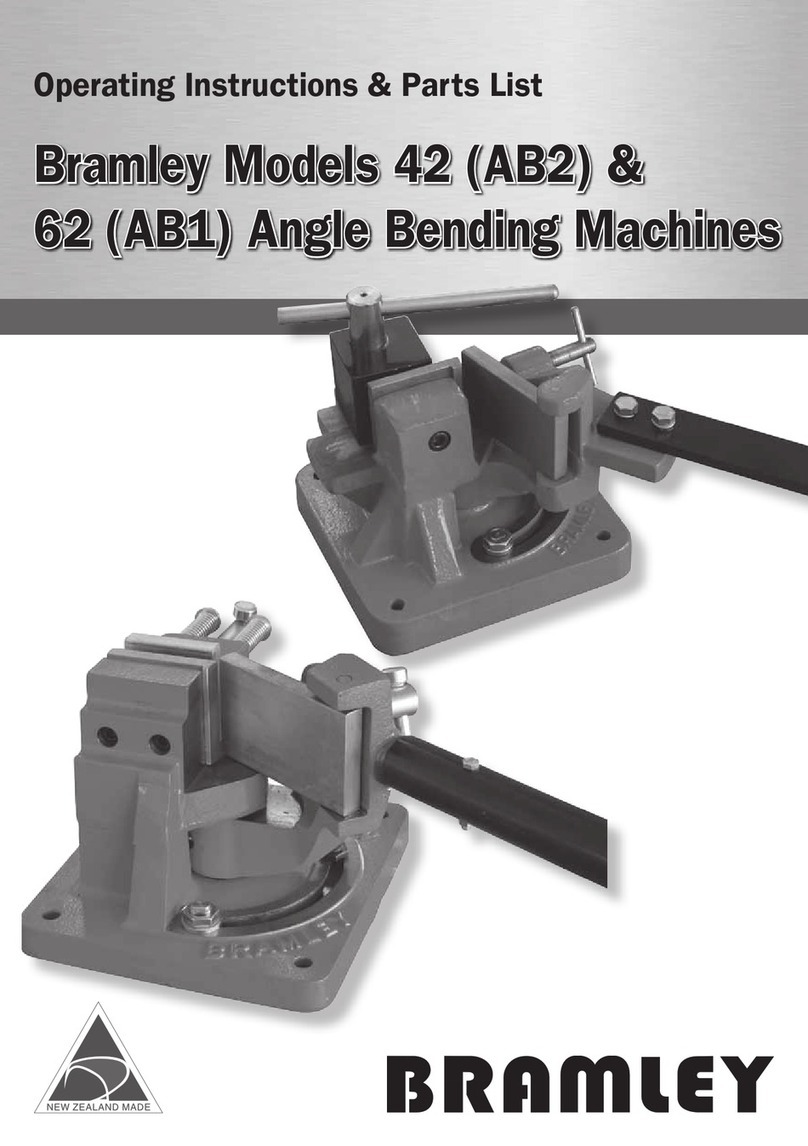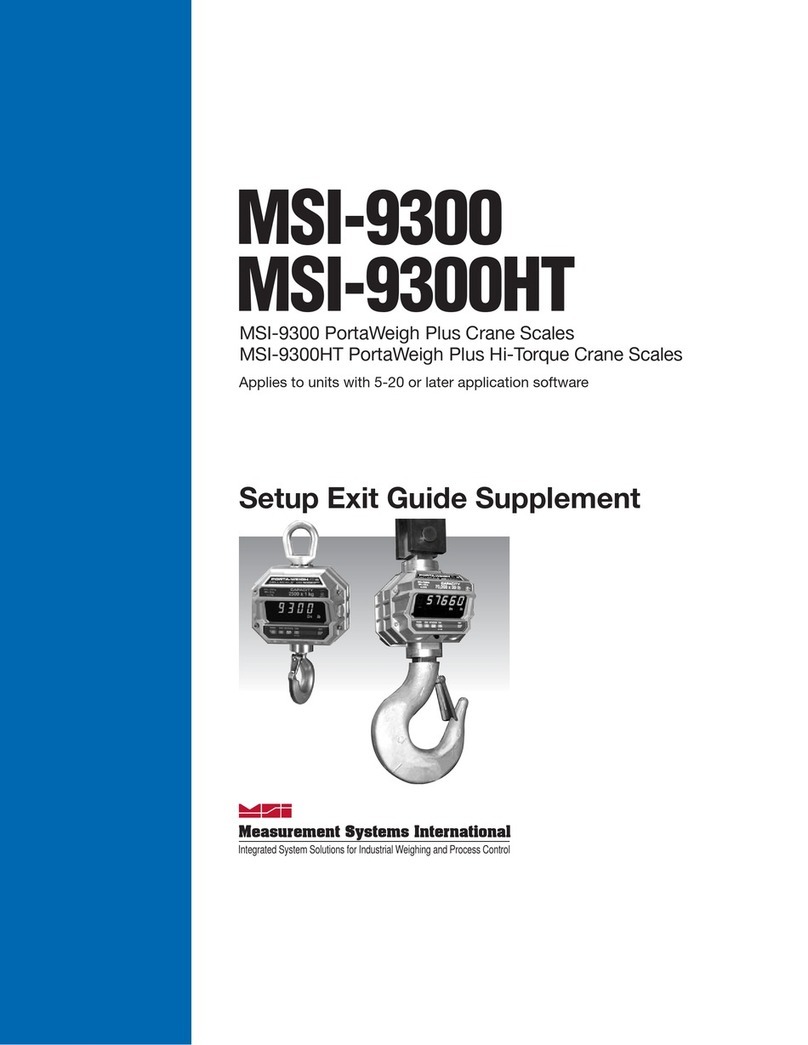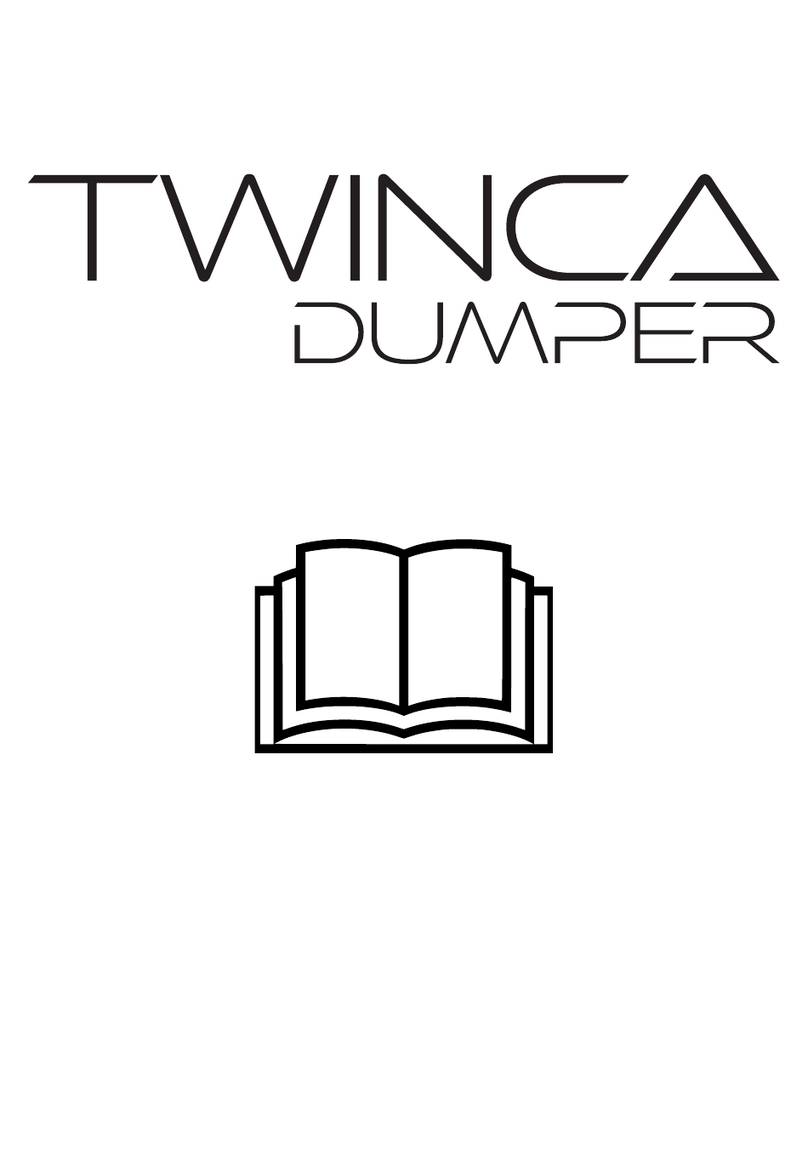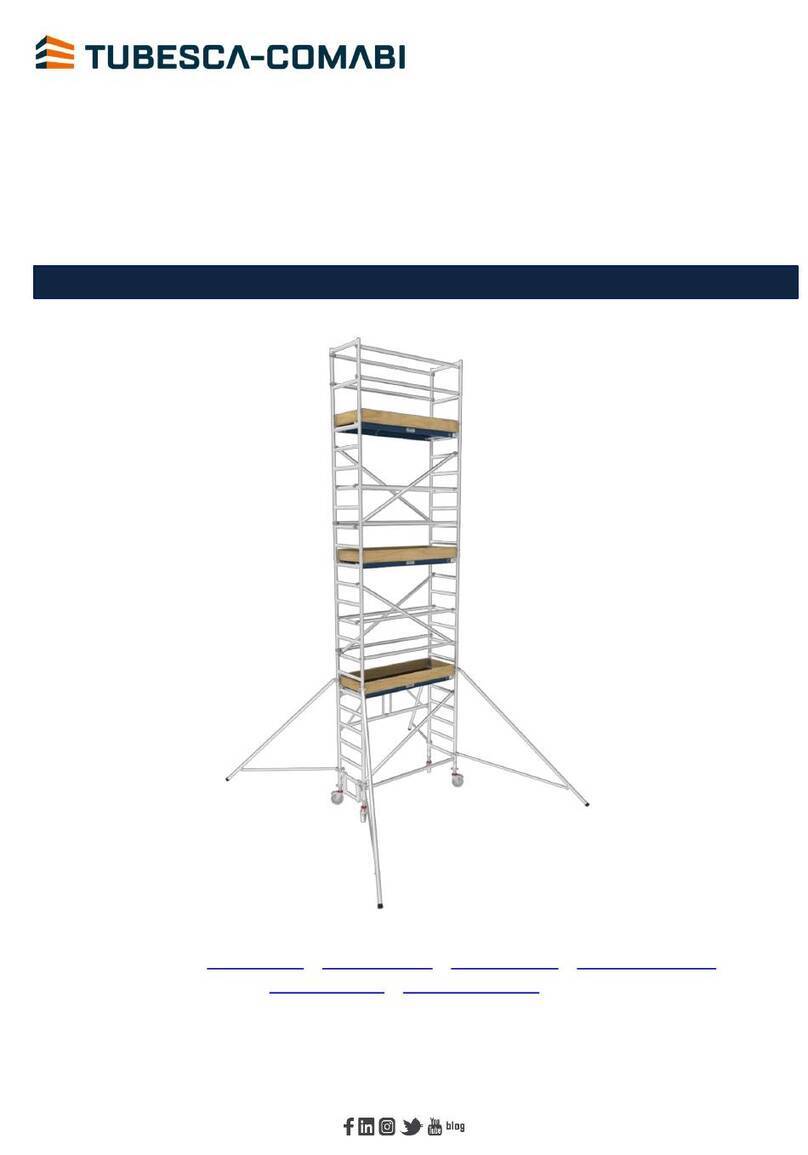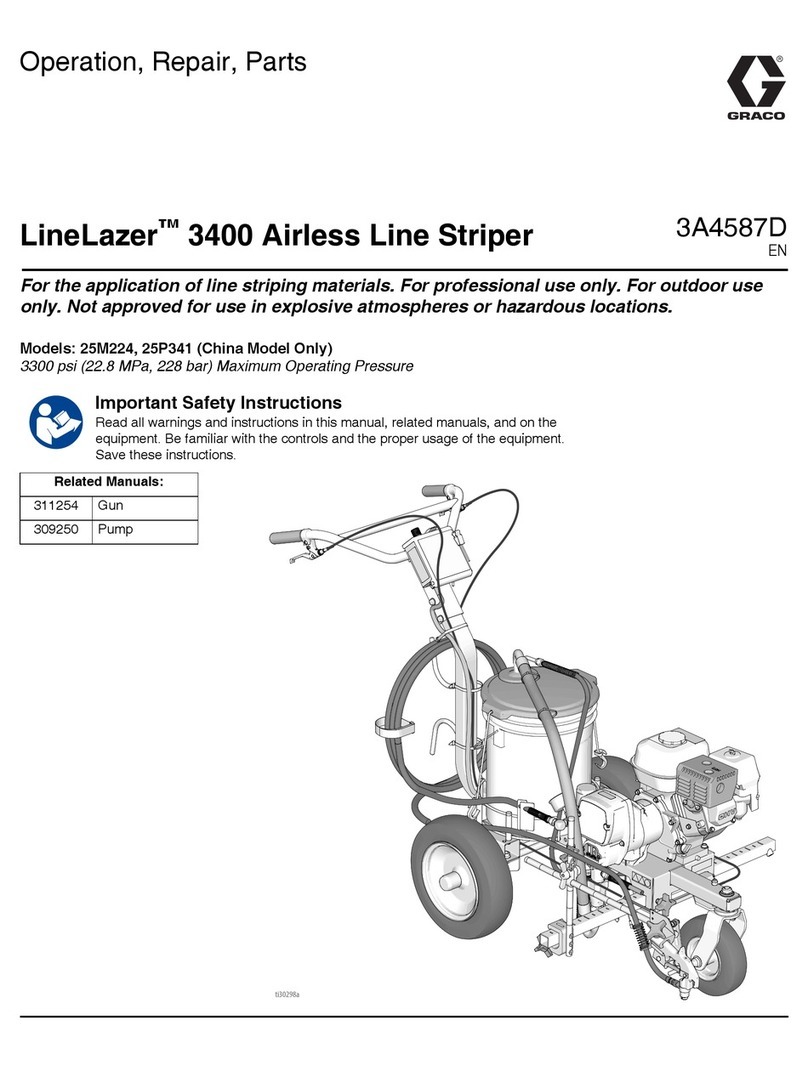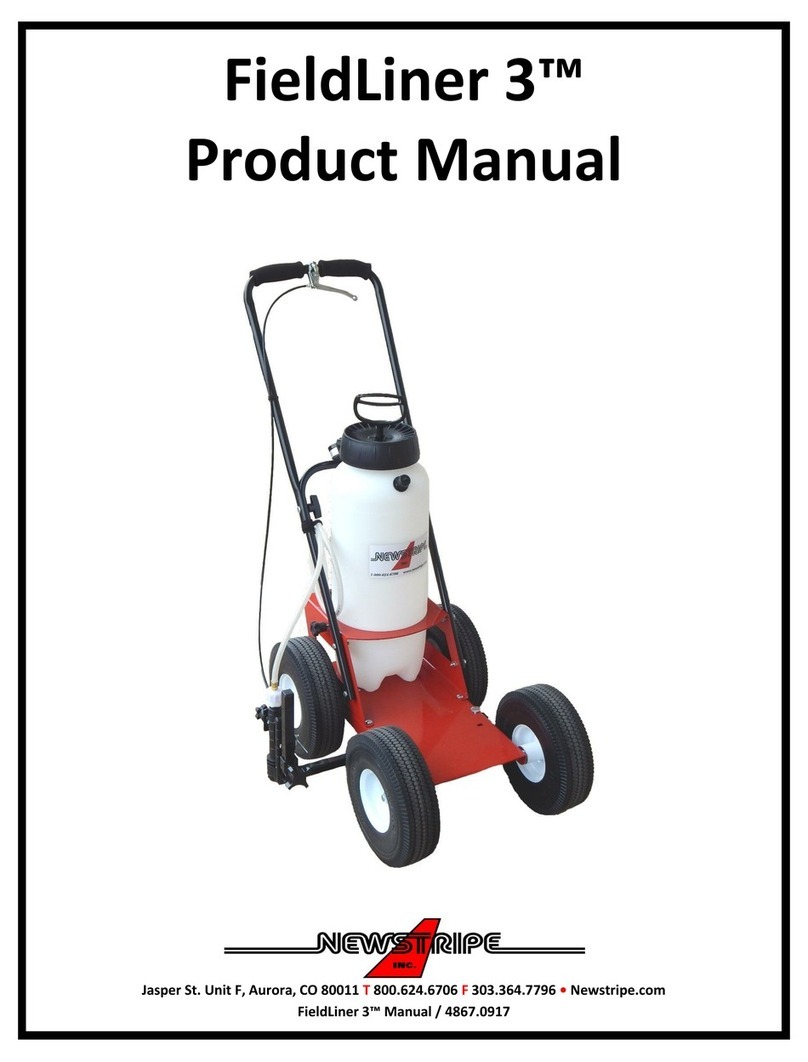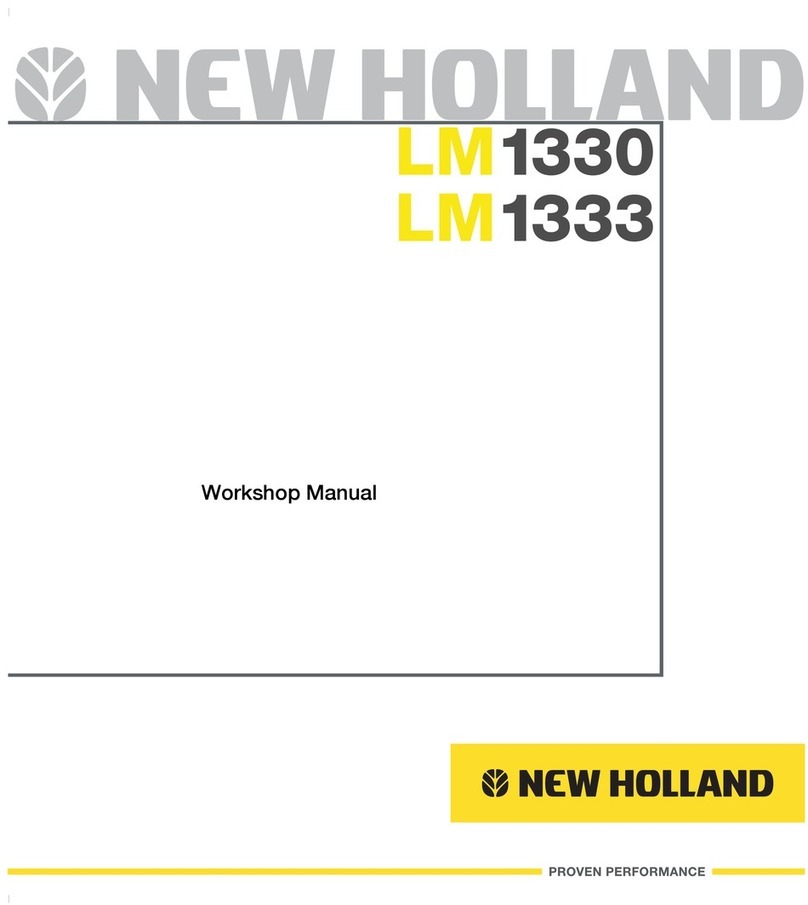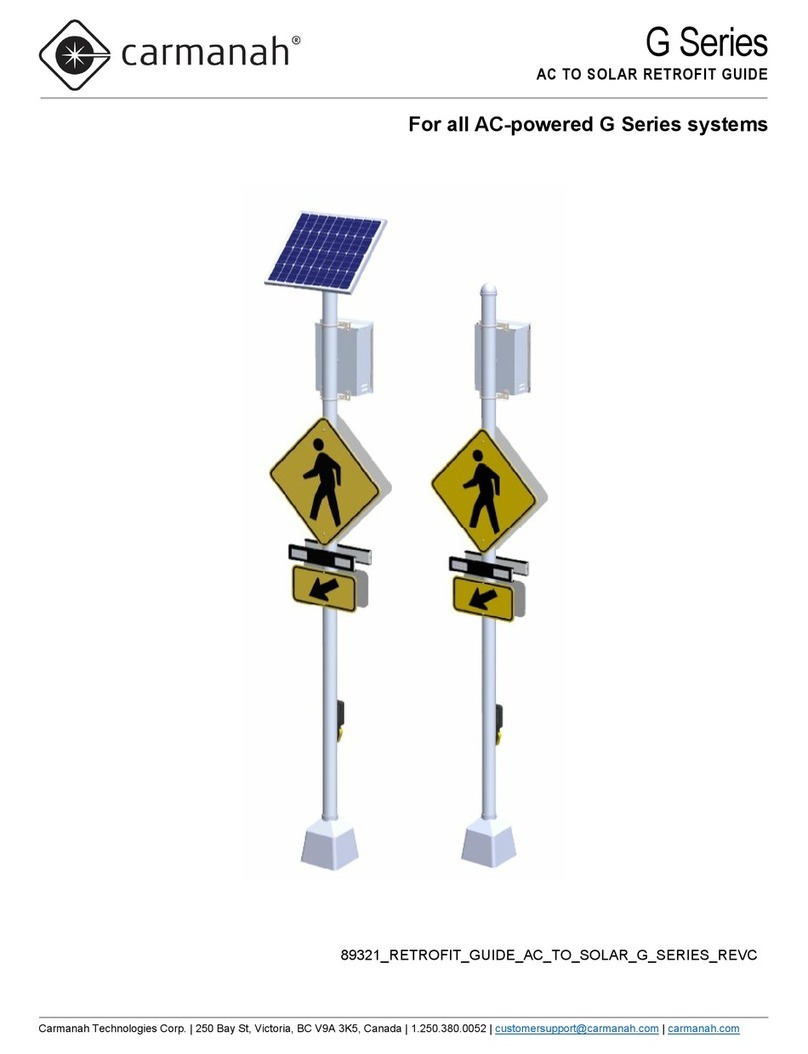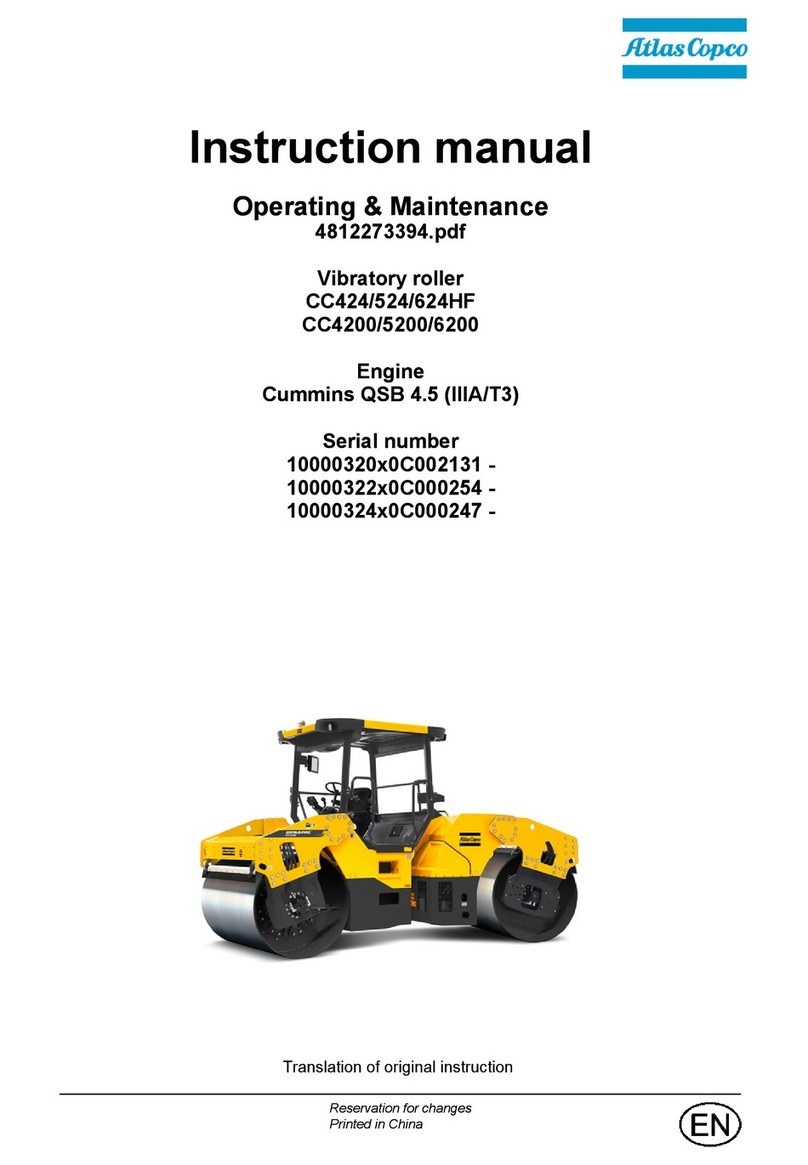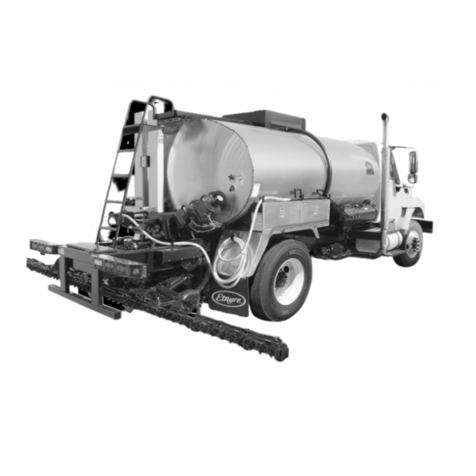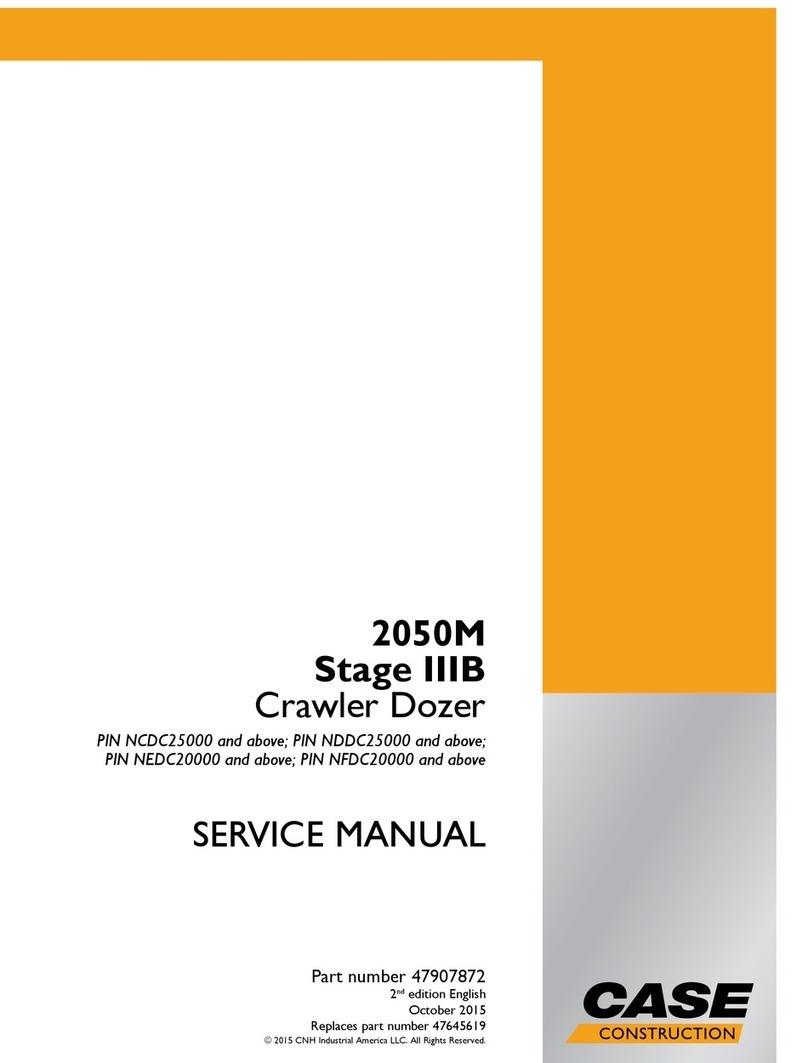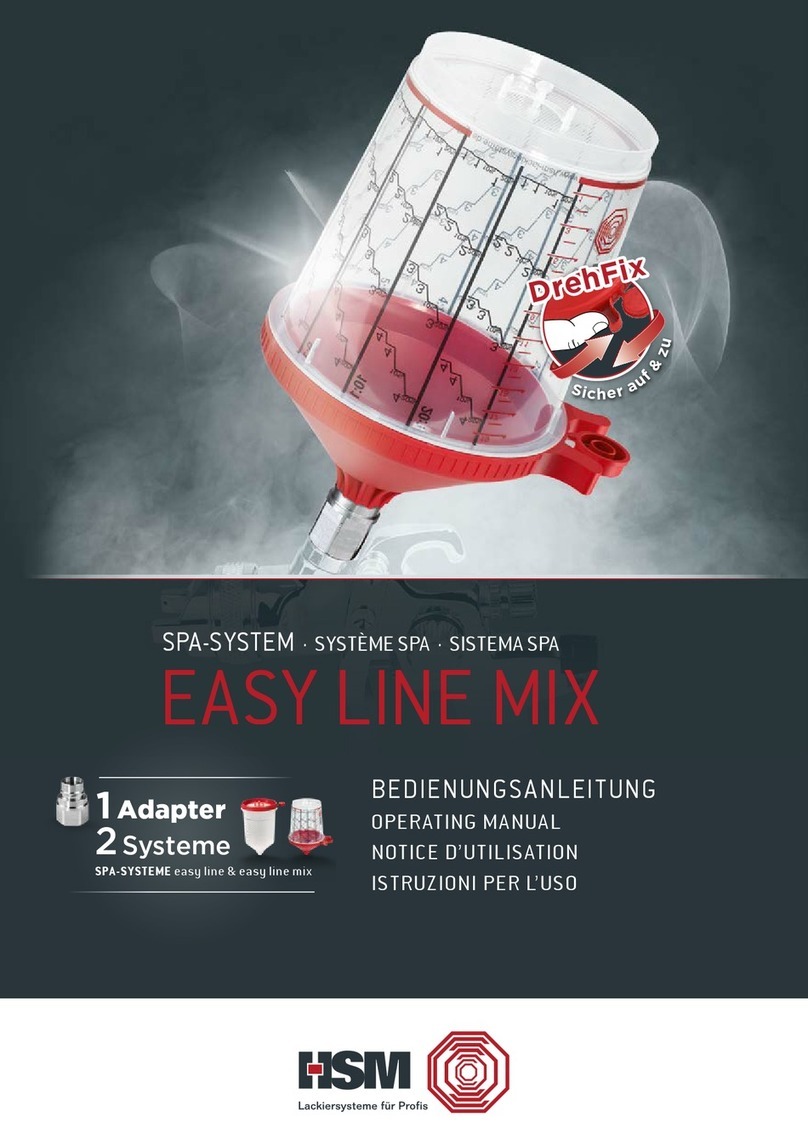Vulcan-Hart V-90 User manual

OWNER'S MANUAL
V-90 / V-100
SAFETY, SPECIFICATIONS, OPERATION, &
MAINTENANCE
NOTE: MANUAL including SPECIFICATIONS, subject to change without notice
All ratings specied are based on structural factors only,
not vehicle capacities or capabilities.
Miller Industries Towing Equipment Inc. FORM NO. 0501128
8503 Hilltop Drive REV. A
Ooltewah, Tennessee 37363 04 / 2011
Phone(423)238-7227•FAX(423)238-7237 PRICE$25.00

LIMITED WARRANTY
MILLERINDUSTRIESTOWINGEQUIPMENTINC.,hereinafterreferredtoasMILLER,warrantstothe
originalpurchaserthateachnewMILLERwreckerorotherMILLERproductswillbefreefromdefects
inmaterialandworkmanshipforaperiodoftwelve(12)monthsfromdateplacedinservice,butinno
eventshallsuchwarrantyperiodexceedtwenty-four(24)monthsfromdateofmanufacturebyMILLER.
ThepurchasermustpromptlynotifyMILLERinwritingofanyfailureinmaterialorworkmanship.Inno
eventshallMILLERacceptsuchnoticationlaterthantwenty-four(24)monthsfromdateofdeliveryor
twelve(12)monthsfromdateplacedinservice,whicheverisearlier.
MILLER's obligation under this warranty, statutory or otherwise, is limited to the repair or replacement
attheMILLERfactory,oratapointdesignatedbyMILLER,ofsuchpartorpartsasshallappearupon
inspectionbyMILLERtobedefectiveinmaterialorworkmanship.Neworremanufacturedpartswill
beusedforanyreplacementatMILLER'soption.Thiswarrantyisnottransferable.Thiswarrantydoes
notobligateMILLERtobearthecostoflaborortransportationchargesinconnectionwiththerepair
orreplacementofanypartsfoundtobedefective,norshallitapplytoaproductuponwhichrepairsor
alterations have been made unless authorized by MILLER.
EXCEPTASEXPRESSLYSETFORTHINTHISWARRANTY,MILLERMAKESNOOTHERWARRANTY,
EXPRESSORIMPLIED,ANDHEREBYDISCLAIMSALLOTHERWARRANTIESINCLUDING,BUT
NOT LIMITEDTO,THE IMPLIED WARRANTIES OF MERCHANTABILITYAND FITNESS FORA
PARTICULARPURPOSE.MILLERshallinnoeventbeliableforclaimeddowntime,claimedlossof
protsorgoodwill,oranyotherspecial,incidental,indirect,orconsequentialdamagesconcerningor
relatingtoanyproductorparts,whetherbasedonnegligence,strictliability,breachofcontract,breach
ofwarranty,misrepresentationoranyotherlegaltheory,regardlessofwhetherthelossresultedfromany
generalorparticularrequirementwhichMILLERkneworhadreasontoknowaboutatthetimeofsale.
MILLER MAKES NO WARRANTY, EXPRESS OR IMPLIED,AS TO THE FINISHED PRODUCTS
MANUFACTUREDORSUPPLIEDBYANOTHERMANUFACTURERANDSUPPLIEDBYMILLER
TOPURCHASER,including,butnotlimitedto,anyvehicletowhichaMILLERproductmaybeafxed
oranyaccessoriesorwirerope,andMILLEREXPRESSLYDISCLAIMSANYIMPLIEDWARRANTIES
OFMERCHANTABILITYORFITNESSFORAPARTICULARPURPOSEASTOSUCHEQUIPMENT
ORPRODUCTS.Thislanguageshallinnowayaffectordiminishtherightsofthepurchasertorely
onsuchwarrantiesasareextendedbysuchmanufacturersorsuppliers.MILLERshall,totheextent
permittedunderapplicablelaw,passontothepurchasersuchmanufacturer'sorseller'swarranty.
MILLER,whosepolicyisoneofcontinuousimprovement,reservestherighttoimproveitsproducts
through changes in design or materials as it may deem desirable without being obligated to incorporate
suchchangesinproductspreviouslysold.Thiswarrantyisnotintendedtocoverorincludethefollowing
items,whicharesetforthbywayofexampleandnotlimitation:
A.Normaldeteriorationoftrim,paint,lettering,andappearanceitemsduetowearorexposureto
weather, road conditions, road treatments, etc.
B.Any damage or defect due to accident, misuse, abuse, improper or unauthorized repairs,
failuretoprovidereasonableandnecessarymaintenance,orusesforwhichtheequipmentwas
not designed or intended.
C.Alterationsormodicationsthataffectperformance,operationorreliability.
D. Normal maintenance parts including, but not limited to, wear pads, bushings, wire rope, mud
aps,fenderettes,lightbulbs,hydraulicoil,lters,andtowslingbelts.
IT IS EXPRESSLY UNDERSTOOD THAT MILLER MAKES NO IMPLIED WARRANTY THAT MILLER
PRODUCTS SHALL BE FIT FOR THE PURPOSE OF LIFTING OR MOVING PEOPLE OR FORANY
OTHER IMPROPER USE.
SERIAL NUMBER
Miller Industries Towing Equipment Inc.
8503 Hilltop Drive
Ooltewah, Tennessee 37363
Telephone (423) 238-7227

i
OWNER, USER AND OPERATOR:
We appreciate your choice of our towing and recovery unit for your
application. Our number one priority is user safety which is best
achieved by our joint efforts. We feel that you can make a major
contribution to safety if you, as the equipment owner and operator:
1. Comply with Federal, State, and Local Regulations.
2. Read, Understand, and Follow the Instructions in this Manual.
3. Use Good, Safe Work Practices in a Common Sense Way.
4. Only have Authorized and Trained Operators running the
Towing and Recovery Unit.
© 2011 MILLER INDUSTRIES TOWING EQUIPMENT INC.All rights reserved. Reproduction
oruse,withoutexpresspermission,ofeditorialorpictorialcontent,inanymanner, is prohibited.

ii
TABLE OF CONTENTS
The operator must read and understand all instructions
in this manual before operating the recovery unit.
It is assumed that the Owner/Operator has a thorough knowledge of the
accepted and lawful retrieval and towing methods as dictated by his city,
county or state. The manufacturer rejects any liability claim that may result
from the incorrect or unlawful application of its equipment.
Section I - SAFETY PRECAUTIONS ..................I-1 thru I-22
SAFE STEERING LOAD, GVWR, GAWR, & GCWR ..I-13 thru I-22
Section II - SPECIFICATIONS .......................II-1 thru II-5
Section III - OPERATIONAL FUNCTIONS
RECOVERY BOOM ............................III-1 thru III-6
UNDERLIFT ................................IIIA-1 thru IIIA-4
Section IV - OPERATING INSTRUCTIONS
RECOVERY BOOM ............................IV-1 thru IV-4
UNDERLIFT .............................. IVA-1 thru IVA-20
Section V - MAINTENANCE .........................V-1 thru V-9
MAINTENANCE RECORD .......................V-6 thru V-9
Section Vl - SCHEMATICS
ELECTRICAL ........................................VI-1
HYDRAULIC SYSTEM .................................VI-2
PNEUMATIC SYSTEM .................................VI-3
ELECTRICAL REMOTE CONTROL SYSTEM ...............VI-4

I-1
Section I - SAFETY PRECAUTIONS
Presented in the interest of safety for all towing and recovery unit
operators.
The danger from an vehicle does not cease when it is disabled
orwrecked.Recovering and towing vehiclescanbe dangerous,
too! The danger threatens towing and recovery unit operators
and everyone close at hand. As a towing and recovery unit
operator you must develop an awareness of the hazards
involved.Youmustuseeverysafeguardwithinreasontoprevent
injuries.
Foreach stepinoperatingyourtowingandrecoveryunitdevelop
the habit of asking yourself if it is safe to proceed. Carefully
check all rigging (especially snatch blocks) before starting a
heavy lift or pull.
We cannot warn you of all the possible dangers you will
encounter. But we will tell you of the most common hazards we
know about. Learn them well.
NOTICE
You are obligated to operate your
towing and recovery unit safely.
You can be held legally responsible
for injuries or damages resulting from
unsafe operating practices.
The manufacturer's recommendations
for operating this towing and recovery
unit can help you avoid unsafe
practices and their bad consequences.
These recommendations are contained
in this manual.
The manufacturer is not responsible
for the results of any unsafe practice of
towing and recovery unit operators.
Furthermore, the division is not
responsible for the failure of the towing
and recovery unit or its accessories
resulting from improper maintenance.

I-2
Section I - SAFETY PRECAUTIONS (cont'd)
1.1 Improper use of this equipment can be dangerous! Incorrect operation
can result in bodily injury to the operator and bystanders. Therefore,
a thorough understanding of the "operating principles" and "operating
instructions" as found in this manual is essential.
1.2 Study each job to be done. Apply common sense judgment to assure
safety to yourself and bystanders.
1.3 Plan ahead. Work safely. Avoid accidental damage and injury. If an
accidentorredoesoccur,reactquicklywiththetoolsandskillsat
hand.Knowhowtousearstaidkitandareextinguisher-andwhere
to get assistance.
1.4 Read and understand the following instructions.
1. READ THE MOUNTING / OPERATING / MAINTENANCE MANUAL
FOR WARNINGS AND PRECAUTIONS.
2. NEVER TAKE ANYTHING FOR GRANTED. DON'T ASSUME THAT
EVERYTHINGISALLRIGHTATTHESTARTOFWORKTODAYJUST
BECAUSE EVERYTHING SEEMEDALL RIGHT AT THE END OF
WORK YESTERDAY. BEFORE BEGINNING OPERATION,
THOROUGHLY INSPECT THE ENTIRE UNIT TO BE SURE IT IS IN
GOOD OPERATING CONDITION.
3. VISUALLY INSPECT THE UNIT FOR EVIDENCE OF PHYSICAL
DAMAGE,SUCHASCRACKING,BENDING,ORDEFORMATIONOF
PLATES OR WELDS. INSPECT CAREFULLY FOR CRACKING OR
FLAKINGOFPAINT, WHICHMAYINDICATEADANGEROUSCRACK
INTHESTRUCTUREBENEATH.DONOTOPERATEUNTILREPAIRS
ARE MADE.
4. LOOSE OR MISSING HARDWARE, BOLTS, NUTS, AND PINS
SHOULD BE PROPERLY TIGHTENED OR REPLACED WITH
MANUFACTURER'S SPECIFIED HARDWARE.
5. CHECK FOR FLUID LEAKS. HYDRAULIC SYSTEM LEAKS MUST
BE CORRECTED BEFORE THE UNITIS OPERATED. INSPECTALL
HYDRAULIC HOSES, ESPECIALLY THOSE WHICH FLEX OR

I-3
Section I - SAFETY PRECAUTIONS (cont'd)
MOVE IN SERVICE,AND REPLACE IF NECESSARY. SECURE ALL
CAPS AND FILLER PLUGS FOR ALL SYSTEMS.
6. YOUR CLOTHING SHOULD BE RELATIVELY CLOSE FITTING.
7. ALWAYSWEAR PROTECTIVE ITEMSSUCHASSAFETYGLASSES,
GLOVES, REFLECTIVE CLOTHING AND SAFETY SHOES.
8. BEFORE OPERATING THE BOOM, REFER TO THE BOOM
CAPACITY LABELS ONTHE BOOMAND INSIDE OF THE DOOR OF
THE CAB AND IN THE SPECIFICATION SECTION OF YOUR
OPERATING MANUAL. FOR CHASSIS CAPACITY CONSULTYOUR
TRUCK DEALER. NEVER EXCEED MANUFACTURER'S LOAD
RATING. THE STIPULATIONS PERTINENT TO THESE RATINGS
SHALLALWAYS BE CAREFULLY OBSERVED.
RATINGS SHOWN ARE BASED ON THE HYDRAULIC,
MECHANICAL, OR STRUCTURAL DESIGN OF THE UNIT RATHER
THAN STABILITY. IT IS ALWAYS UNSAFE TO APPLY ANY LOAD
WHICH IS GREATER THAN RATED LOAD SHOWN ON THE DATA
PLATE.
9. DO NOT USE THIS EQUIPMENT EXCEPT ON SOLID, LEVEL
SURFACEWITHSTABILIZERSPROPERLYEXTENDEDANDTRUCK
BRAKES LOCKED.
10. OPERATE ALL CONTROLS SLOWLY AND SMOOTHLY TO AVOID
DAMAGE TO UNIT OR INJURY TO PERSONNEL.
11. DO NOT OPERATE, WALK OR STAND BENEATH BOOM OR A
SUSPENDED LOAD.
12. NEVER LIFT LOAD OVERANYONE.
13. DO NOT USE BOOM TO LIFT PEOPLE.
14. KEEP LOAD WITHIN ONE FOOT OF THE GROUND WHENEVER
POSSIBLE.
15. FOR TRAVEL, BOOM MUST BE IN STOWED POSITIONAND PTO
DISENGAGED.

I-4
Section I - SAFETY PRECAUTIONS (cont'd)
ONLY AUTHORIZED AND TRAINED PERSONNEL SHOULD
BE PERMITTED TO OPERATE THIS UNIT UNSUPERVISED.
TRAINED PERSONNELARE THOSE WHO HAVE WORKED
UNDER EXPERIENCED SUPERVISIONAND HAVE
PERFORMED ALL TOWINGAND RECOVERY MANEUVERS,
HAVE READ THE MOUNTING, OPERATING AND
MAINTENANCE MANUAL, WARNINGS AND PRECAUTIONS,
AND UNDERSTAND AND HAVE HAD EXPLAINED TO THEM
BY THEIR EMPLOYER THE HAZARDS OF OPERATING THE
UNIT. THEY MUST BE FAMILIAR WITH THE HAZARDS OF
OPERATING AT A SITE WHERE ELECTRIC POWER LINES,
IRREGULAR GROUND CONTOUR, WATER, ICE, MUD, OR
OTHER CONDITIONS CAN INTERFERE WITH ORDINARY
CAREFUL OPERATION OF THIS UNIT.
AN UNTRAINED OPERATOR SUBJECTS HIMSELF AND
OTHERS TO DEATH OR SERIOUS INJURY.
THIS MANUAL IS DESIGNED TO PROVIDE A REFERENCE
FOR THE OPERATION OF THIS EQUIPMENT. IT IS
RECOMMENDED THAT ALL OPERATORS ATTEND
A TRAINING AND CERTIFICATION PROGRAM SUCH
AS THOSE OFFERED BY MANY STATE TOWING
ASSOCIATIONS, TRAA,OR TRAINING ORGANIZATIONS
SUCH AS WRECKMASTER BEFORE OPERATING THIS
EQUIPMENT.
STAND CLEAR
WHILE OPERATING REAR SPADES

I-5
Section I - SAFETY PRECAUTIONS (cont'd)
SAFETY TIPS
USE SAFETY CHAINS ON ALL TOWING
AND LIFTING APPLICATIONS.
Don't use winch cables with
hooks attached by means of
cable clips. Use only cables with
hooks attached by means of
thimbles and machine swaged
terminals.
Death or serious injury can
occur when working near
power lines.
Learn - beforehand - as
much about your working
area as possible. Be sure
that exact locations of
overhead power lines, and
other obstructions or
hazards are known.

I-6
Section I - SAFETY PRECAUTIONS (cont'd)
SAFETY TIPS
Don't use a towing and recovery
unit that has not been properly
maintained. Pay special attention
to mounting bolts, cable condition,
and lubrication of moving parts.
After rigging cables, don't begin
pulling without rechecking
connections. Make sure that all
cables and snatch blocks are
securely attached and cannot
accidentally pull loose.
Alwaysusetwosafetychainswhen
towing all vehicles, regardless of
distance.
Don't use damaged cables on
the unit. Become familiar with the
varioustypesof cable damageand
carefully inspect all cables being
usedinarecoveryoperationbefore
starting to pull.

I-7
Section I - SAFETY PRECAUTIONS (cont'd)
SAFETY TIPS
Don'texpecttheunittotowloads
equal to the boom rating. Ratings
apply to loads imposed during
recovery, with the unit properly
stabilized.
Don't pull a load with the unit
withoutmakingabsolutelysurethat
the winch drum clutch is FULLY
engaged.
Don't attempt to recover heavy
loads without rst estimating the
amountof pullthat willbe required.
Rigtokeeptheestimatedamountof
pull well within equipment ratings.
Don't exceed ratings of booms,
cables, snatch blocks, or winches.
Stay within data plate ratings.
Note that boom ratings decrease
signicantlyasaboomisextended.

I-8
Section I - SAFETY PRECAUTIONS (cont'd)
SAFETY TIPS
Don't disengage the winch drum
clutch while the winch cable is
loaded.
Don't tie down the front end of the
unitforrecoveryworkorheavy lifts.
You are apt to damage the truck
frame if you do.
Don't exceed WORKING LIMIT
ratings of cable. Use breaking
strength ratings only for selecting
replacement cable.
Don't get under a raised vehicle or
load unless it has adequate safety
blocks in place.

I-9
Section I - SAFETY PRECAUTIONS (cont'd)
SAFETY TIPS
Don'tmove the unit while outboard
legsorrearspadesareextended.
Don'tpermitbystandersin the area
while performing recovery work.
Don't use rear spades on paved
surfaces unless you are willing to
accept responsibility for possible
damage to such surfaces.
Don't lower outboard legs or rear
spades unless area under them
is clear. Pay particular attention to
keeping this area clear.

I-10
Section I - SAFETY PRECAUTIONS (cont'd)
SAFETY TIPS
Don'ttowavehiclethatreducesthe
weight on the front wheels of the
unit more than 50 percent.
Don’t rely on anti-theft steering
locks. Use special steering wheel
clampingdevice.Ropeiscommonly
usedtosecuresteeringwheels,but
that is not as reliable as devices
designed for this purpose.
Don’t operate the unit's engine
faster than recommended.
Excessive speeds can damage
PTO shafts, hydraulic pumps and
winches.
Don't completely unwind all cable
from a winch while loaded. Keep
ATLEASTvewrapsonthedrum.

I-11
Section I - SAFETY PRECAUTIONS (cont'd)
SAFETY TIPS
Don'ttravelwith the PTOengaged.
Engage it only while operating the
unit controls.
Afteryouhave hooked upavehicle
for towing, don't start the tow until
you have double checked the
hook-up, installed safety chains
and released the parking brakes
on the towed vehicle.
Don't use towing forks that are
not of proper size for pick-up
requirements.
Don't tow a vehicle on its drive
wheels unless steps have been
taken to protect its transmission
and differential. Follow the
recommendations of the vehicle
manufacturer. As an alternative,
use a towing dolly.

I-12
Section I - SAFETY PRECAUTIONS (cont'd)
SAFETY TIPS
Don't tow a vehicle without tow
lightsinstalledonthetowedvehicle.
Don't tow a vehicle on its front
wheels unless the steering wheel
is secured with the front wheels
straight ahead.
Don't tow a vehicle on its front
wheels if they are damaged.
Don'tdriveunitwithboomelevated.

I-13
Section I - SAFETY PRECAUTIONS (cont'd)
SAFETY TIPS
SAFE STEERING LOAD, GVWR, GAWR, &
GCWR
1.1 CHASSIS LIMITATIONS
Safe operation of your equipment is limited not only by the ratings of
your equipment, but also by the amount of weight remaining on the
frontaxlewhentowingandbyyourchassisratings.
When towing a vehicle it is important that you:
1. Maintainatleast50%oftheoriginalweightonyourfrontaxlefor
steering. 50% is generally accepted by the towing industry as the
amountoforiginalfrontaxleweightthatshouldbemaintainedon
thefrontaxleforsafesteeringundergoodtowingconditionson
pavedsurfaces.Morethan50%oftheoriginalfrontaxleweight
shouldbemaintainedonthefrontaxlewhentowingongravel
roads, wet surfaces, snow or other adverse towing conditions.
Don’t continue to wind in winch
cable after the hook is against the
boom end.
Don’t move unit or extend boom
where overhead power lines may
be encountered.

I-14
Section I - SAFETY PRECAUTIONS (cont'd)
SAFE STEERING LOAD, GVWR, GAWR, &
GCWR (cont'd)
1.1 CHASSIS LIMITATIONS (cont'd)
Furthermore, information may be available from your chassis
manufacturerthattellsyoutomaintainaspecicamountofweight
onthefrontaxleofyourchassisforsafesteering.Ifthechassis
manufacturer recommends that you should maintain more weight
onyourfrontaxlethansafesteeringformulaindicates,thenyou
should adhere to the manufacturer’s recommendation.
2. DonotexceedtheGVWR(GrossVehicleWeightRating)ofyour
chassiswhenyouaretowingaload.ExceedingtheGVWRof
your chassis can affect its braking and handling.
3. DonotexceedtheGAWR(GrossAxleWeightRating)ofyour
truck.
4. DonotexceedtheGCWR(GrossCombinationWeightRating)of
yourtruck.ExceedingtheGCWRcanaffectbrakingandhandling
of your chassis.
1.2 CALCULATING SAFE STEERING LOAD
Whenyouobtainatowtruck,youshouldcalculateitsmaximumload
for safe steering. If it has more than one towing device installed, you
should make the calculation for each device. You should record that
information on a sticker and put it in the cab within easy view of the
driver/operator. All drivers should be required to observe the limits
shown on the sticker. Decals for this purpose are available from
Vulcan.
Themaximumtowingloadforsafesteeringisthemaximumload
that can be lifted without making the tow truck steering traction
unreliable and dangerous. It should be calculated after all equipment
is mounted.
Weight on the steering wheels should NOT be reduced to less than
one-half of their unladen weight.

I-15
Section I - SAFETY PRECAUTIONS (cont'd)
SAFE STEERING LOAD, GVWR, GAWR, &
GCWR (cont'd)
1.2 CALCULATING SAFE STEERING LOAD (cont'd)
Asimpleformulaforcalculatingthemaximumliftedloadforsafe
steering is shown below. It is based on the requirement for maintaining
one-half the unladen steering weight.
This formula has been used by the towing industry for many years
andhasprovenreliablefordeterminingthemaximumliftedloadfor
safe steering under good towing conditions as stated above.
ML = 1/2 FAW x WB / OH
where:
AL = maximumliftedloadforsafesteering.
FAW = theunladen(unloaded)weightatthefrontaxle.
WB = wheelbase(distancebetweenthecenterofthefrontaxle
andthecenteroftherearaxle(s)
OH = overhang(distancefromthecenteroftherearaxle(s)to
the lift point of the towing device.
Tousetheformula,dividetheunladenweightatthefrontaxleby
two. Multiply the result by the wheel base. Then divide that result by
theoverhang.Thelastnumberyougetisthemaximumliftedload
for safe steering.
Use the step by step instructions that follow to calculate safe steering
tow loads for various types of towing devices. Do the calculations for
each type of towing device installed on your tow truck.
Usethisproceduretocalculatethemaximumtowloadwhenusinga
wheel lift, under lift, towing sling, tow bar, or truck hitch. Use this
procedure only for those devices mounted on a tow truck.

I-16
Section I - SAFETY PRECAUTIONS (cont'd)
SAFE STEERING LOAD, GVWR, GAWR, &
GCWR (cont'd)
1.2 CALCULATING SAFE STEERING LOAD (cont'd)
You can use pounds and inches or centimeters and kilograms in
your calculations. If you use kilograms instead of pounds and
centimeters instead of inches, the safe steering limits will be in
kilograms.Donotmixpoundsandkilogramsnorinchesand
centimeters in the same calculation. If you use kilograms, convert
the chassis ratings to kilograms before making calculations.
Calculations for car carriers are not covered in this manual. They
require additional calculations because vehicles may be carried on
their beds.
1. Weigh the truck at its front and rear wheels and note the weight in
either pounds or kilograms. Make sure the truck has a full tank of
fuel, that the driver is in the cab, and that the truck is unloaded,
exceptforusualtowingequipment.Ontruckswithtandemaxles,
includethecombinedweightofbothrearaxles.SeeFigure1.1.
FIGURE 1.1
2. Carefully measure the wheel base and note the distance in either
inches or centimeters. See Figures 1.2 & 1.3.
This manual suits for next models
1
Table of contents
